Boots on the ground in the wilds of South Africa
NB: For this story, I wouldn’t normally disclose our location; wildlife is threatened enough as it is. However, migration patterns, the passage of time and the reassurance of an expert means the risk is low enough.
I leapt from the modified Land Rover Defender, landing heavily on chalky earth. The vehicle creaked as the group dismounted.
We were deep into the Timbavati Game Reserve, located within the Mpumalanga province of South Africa. Prided for the limited incursions humans have made over millennia, this land is celebrated for being “untamed”.
With the fences bordering Kruger National Park removed, predator and prey roam freely across millions of hectares of bushveld. Guided by experts from Motswari Safari Lodge, we were going to walk in their tracks.
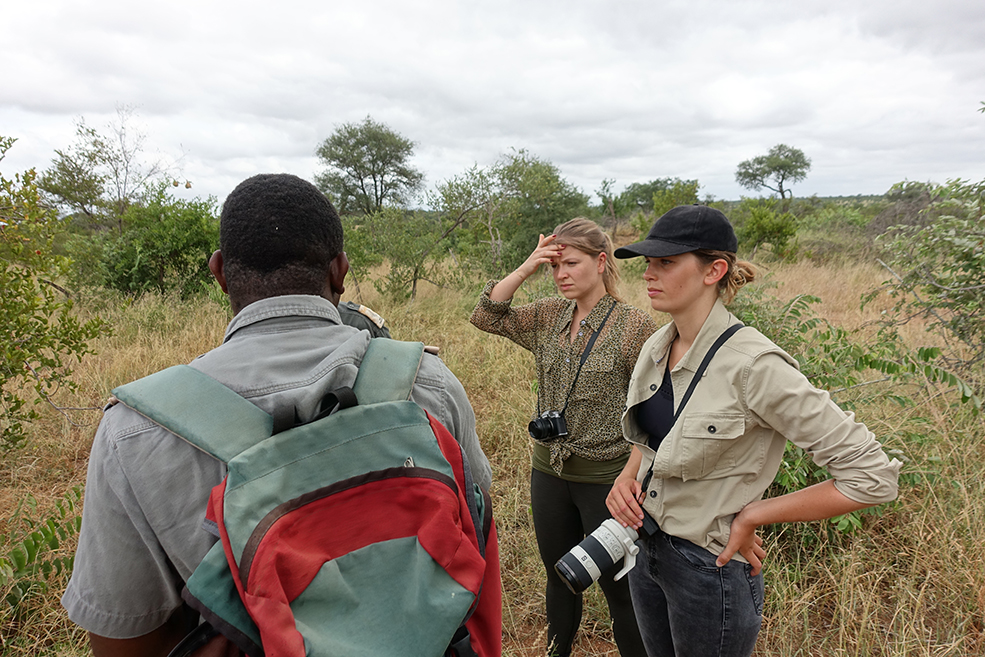
Elise and Paola listen intently to Sinhle’s briefing.
Called into formation through whispered breath, I surveyed our group of 6 enthusiastically. It was 3 on 3. Ensuring our protection was: Gina, a young guide who left behind the concrete jungle of Johannesburg for the bush; Petros, our tracker, whose shadowed eyes darted alert and incessant; and Sinhle, our lead guide, whose sleight of hand with a Winchester rifle betrayed the youth of his round face marked playfully by a signature goatee.
As for the guests (or potential liabilities) we had: Elise, the wildlife filmmaker who freely expressed excitement with dangerous squeals; Paola, who originated from Poland and bravely left Lorenzo, her partner, behind to join the expedition; and myself, whose experiences of African wildlife thus far would be best described as memorable.
As our guides cautiously loaded their rifles with giant .458 cartridges—capable of taking down a charging elephant should the worst occur—we were briefed to stay in formation, to remain silent and if the worst were to occur, to never run.
So we set off—Sinhle and Gina ahead, Petros at the rear—to spend 90 minutes getting well-acquainted with the natural world. Contrasts of grey sky with stifling heat, rustling wilderness with wordless marching, lent a moody intensity to the situation.
You don’t undertake a bush walk for the big stuff. The purpose is to guide you on the flora and fauna that you’d miss on a safari drive. While every precaution is taken to protect guests, you’re an order of magnitude more likely to see the spots of a leopard tortoise than the stripes of a zebra.
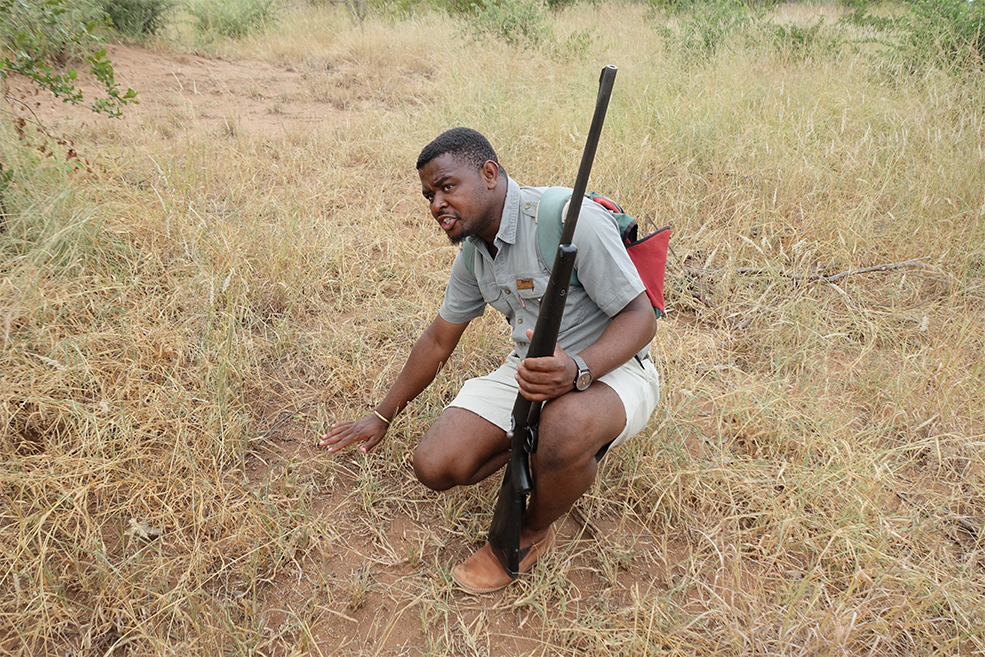
Sinhle analyses the dirt to identify the tracks recently left by wildlife.
It wasn’t long before Sinhle crouched to point out a faint marking in the sabulous path ahead. Invisible to the untrained eye, 4 compact and indistinct blobs slowly revealed themselves in the dust.
‘This,’ whispered Sinhle, ‘belongs to hyena.’
I surveyed the bleached long grass that swayed in the breeze. Sometime before us, an animal with a bite force capable of crushing bone had trotted down the very path we were stood on. My forearms tingled, hair bristling with the wind.
The group moved along in silence, save for the clicks of kicked pebbles and snaps of baked sticks. Each misstep felt like a betrayal to Petros who kept a vigilant ear to the air.
Eventually Sinhle brought us to a tree made unique by its fingers of tiny oval leaves. Gina kept a perimeter, propped up by her rifle. This was the African Wattle tree (Peltophorum africanum), and its soft, absorbent leaves could be used as toilet paper—particularly valuable if stuck in the bush for several days.
We turned off the path, our vehicle about a kilometre behind, and the chalk of the road morphed into a reddish dirt. Mopane trees quickly obscured our lead as we meandered through shrubs that tickled my shins. Elise grinned over her shoulder while Paola’s blonde ponytail bobbed in sync with the holstered rifles. I marvelled at our guides’ ability to navigate with such purpose that it seemed pre-determined.
Minutes passed and the longer we walked, the more entwined the flora became. Suddenly, Petros let out a short, soft whistle that brought Sinhle to an immediate halt. A horizontal arm indicated for us to crouch down and come forward. The three guides smiled knowingly while I frowned against the mystery of their satisfaction.
Eyes locked on the tips of the grass ahead, my puzzlement melted into awe as a curved horn raised upwards. It was, unmistakably, the horn of a southern white rhinoceros.
The plight of the rhino is real. Upon arrival at the Timbavati Park gate, my curiosity got the better of me and I clumsily enquired about the poaching situation.
The warden hesitated. ‘It’s tough,’ he sighed while stamping our tickets.
My misplaced question piqued the concern of a stocky Afrikaner with the sun-beaten face of a rugby prop. He calmly but assertively asked to search the car and circled with a similarly-built sniffer dog. Once his posture relaxed, I asked what he was looking for. A live round was produced from his khaki chest pocket and he smiled at once dutiful and intimidating.
Their concern was justified. Once thought extinct, the southern white rhino population has hung in the balance having been hunted by colonial Europeans for trophies, and now by Chinese and Vietnamese markets for the aphrodisiac properties their horns are believed to contain. This despite consisting primarily of keratin (the same as our hair and nails) which science has proven has no medicinal value whatsoever.
Thankfully, the future’s looking brighter with rhino poaching in South Africa officially in decline. But with less than 20,000 southern white rhinos left, it was a privilege to come eye-to-eye with one.
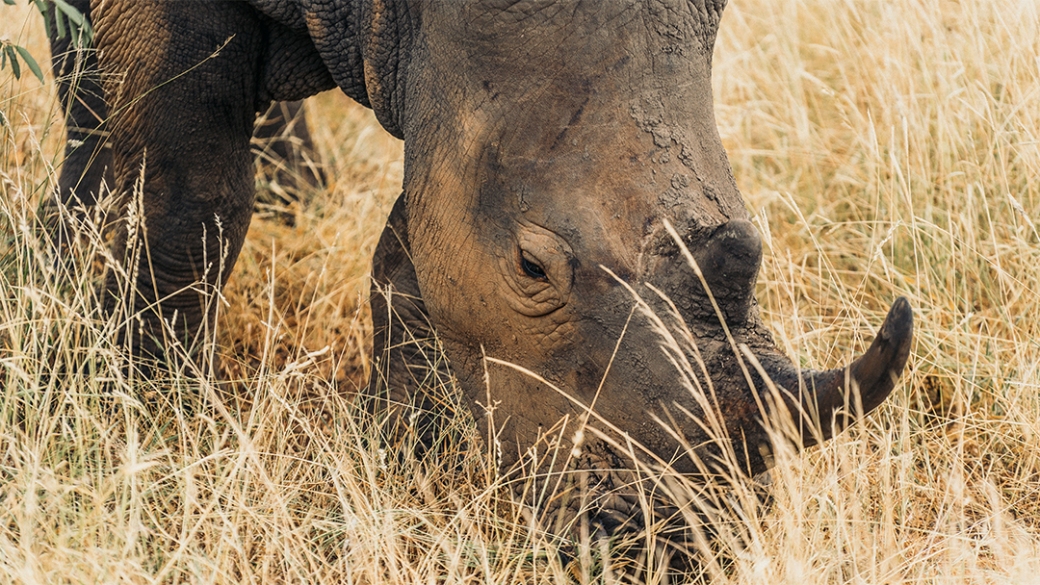
The embodiment of majesty. Photo Credit: Elise Gibbins
However, I was acutely aware that despite its gentle disposition, we were within charging distance of a 2 ton juggernaut. My eyes widened upon Petros’ muttered revelation that there was two of them.
We were downwind but the breeze would obscure their hearing, making them nervous. I could see the furrow of a wrinkly grey brow, but the radar dish rotation of their almond-shaped ears indicated that we hadn’t been detected. Yet.
I held my breath in the electrified air, humbled by the sheer weight of their presence. This was until the yellow-billed oxpecker that grazed on their backs—a symbiotic relationship in which parasites are exchanged for predator alarms—gave out an extended trill. Rumbled.
Sinhle led our squatting group in retreat and we flanked the clearing from a distance. My mind raced at the sheer fortune of this encounter, for this was something that rangers don’t see every day, let alone guests on a bush walk. We continued on for some time, nervously watching our backs, and by this point I’d lost all sense of orientation.
Suddenly, the machine-gun like cacophony of a felled tree sounded in the distance. We stopped immediately in single file and waited.
This time I sensed it first—a deep hum, barely audible so that you felt the bones in your ear vibrate before hearing. I turned to Petros as he scanned the bush and mouthed what was both an instinctive hope for the encounter, but also fear. Where was it? Was it behind us? Petros signalled to Sinhle via his trademark whistle, and we pressed on slowly.
A few yards in front, overhead leaves surged to reveal bright arcing tusks. At 11 feet, the hum’s source towered above, chomping on the fruitless branches of a marula tree—a 6 ton bull elephant.
I quickly felt we’d been miniaturised.
Elephants have given reason for optimism in recent years thanks to their active reproduction. But the persecution continues, not helped by proposals to resume ivory sales in countries like South Africa. Thankfully, these proposals were voted down. However, studies have shown that despite a domestic ban in China, regular outbound Chinese travellers have the greatest interest in purchasing ivory. Sadly, an estimated 35,000 elephants are killed annually due to poaching and culls justified by claims of overpopulation.
He knew we were there. The 40,000 muscles in an elephant trunk hold sensors that can detect water from a distance of 20 kilometres. But the snapping of branches and his lethargic flapping ears indicated that a charge wasn’t necessary… if we kept our distance.
Under the shade of her cap, Gina smiled in admiration at her favourite of the Big 5. A few moments later, Sinhle directed us to leave before we outstayed our welcome.
Time had no meaning now. The African sun, masked by an overcast sky, pressed creases into my sweat-stained shirt. Walking was made uncomfortable by prickly grass seeds that pierced into my boots like needles.
For all I knew, we were headed back. But Sinhle had spotted something. Fixated on the sand, he led us in an arc round a robust acacia thicket to a clearing of dried grass. He stopped with a satisfied expression and pointed into the distance.
We were being watched.
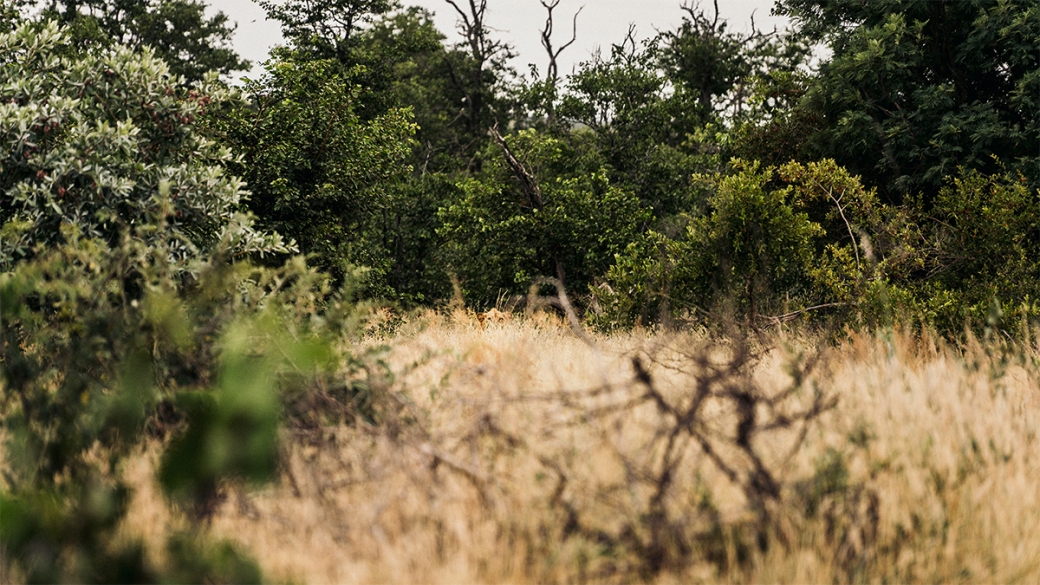
I strained my eyes for several minutes, conscious of the banded golden orb-web spider that splayed itself in the web beside. Gina passed her binoculars. As I panned across the golden crop, I was forced into a gasp made raspy by a parched throat. Staring back through the lens was the panting face of a young male lion.
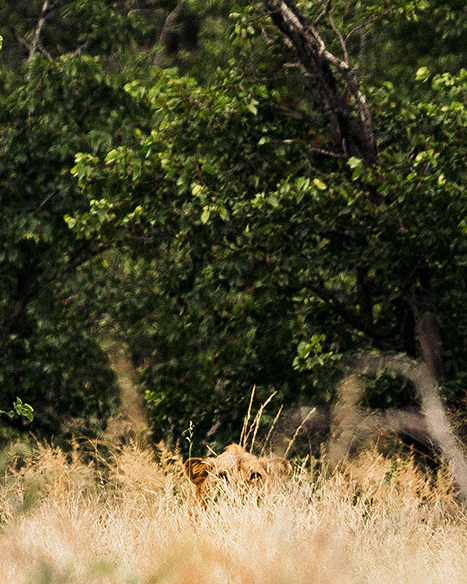
Of all the animals to be most threatened by human-wildlife conflict, it is the lion. As human settlements increase, along with the livestock that sustains them, the lion’s territory contracts. With goats and cattle easy prey, lions face retaliatory killings from farmers. This, along with health problems caused by inbreeding, has forced the IUCN to class their population as Vulnerable, with only an estimated 23,000 left in the wild.
My heartbeat accelerated with the realisation that at just 30 yards away, this King of the Savannah, prone and so perfectly camouflaged, was completely invisible to my untrained eyes. He then swiftly rose, poised to walk away, but gaze fixed upon us. 3 metres in length, the predator revealed its mass of muscle, claws and teeth. And just like that, he leapt out of sight.
We had a problem now. The cat looked healthy and therefore more predictable. But we couldn’t rule out the possibility that we were being stalked. Sinhle and Gina hung back to protect the rear, while Petros led us on a hidden trail through mopane trees.
I stepped carefully to avoid the burrow of a sleeping baboon spider, its web shimmering with dew that had yet to evaporate. Occasionally, a spider-hunting wasp would drone past with the whir of a tiny helicopter, two long legs dangling in the air. These wasps have a particularly gruesome means of survival; they use their sting to paralyse their prey which becomes a host for their eggs. Once hatched, the larvae devour the prey alive.
Emerging from the bush onto the familiar chalk road, a blue wildebeest took offense to our dishevelled appearance with a judgmental snort. And as we approached our vehicle, a red-billed hornbill landed clumsily onto a tree branch to greet us.
We checked the time. What was to have been a gentle 90-minute walk had turned into a 3-hour expedition. I would’ve been happy with a sedate education on poison tree sap, termite mounds and African bushcraft. Instead, we came face-to-face with 3 of the Big 5 on a fast evolving on-foot safari. For context, you’ve had a good safari drive if you see one of them.
Adrenaline flowed and we exuberantly expressed our gratitude as we climbed aboard, feet throbbing and calves burning. Gina ignited the engine, creaked the gears and we shuddered on.
As we trundled back to camp, skin-reddened and encased by dust, I reflected optimistically on the changes our species was capable of making. When we discuss the poaching threat, it’s often forgotten that our colonial ancestors once felt it was their right by conquest to “tame” the wilds of Africa; but just over a century later, here we were trying to protect it.
With the outbreak of Covid-19 suspected to be linked to the wildlife trade, perhaps the vulnerability of our species will bolster this effort.
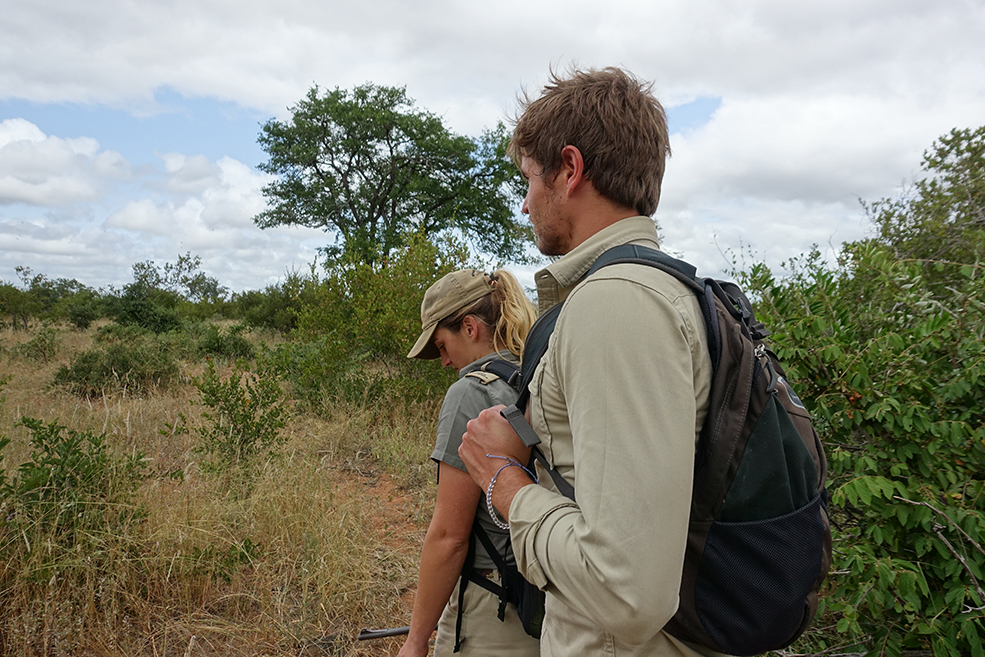
Chris Dennett (yours truly) and Gina looking intently into the bushveld.
A huge thanks to our guides from Motswari Safari Lodge for protecting us on this unplanned and unforgettable experience.
Quarantine is keeping the vast majority of us indoors. If any of you want to go on safari via your screens, I recommend the daily live streams of WildEarth. If you’re lucky, you’ll be guided by my friend Shaun Marshall.
wow, amazingly written. a hint of murakami perspires at the beginning… you should write an africa adventure fiction my friend!
LikeLike
A wonderful read exciting and informative 👍👏👏👏
LikeLike
A wonderful read exciting and informative 👍👏👏👏
LikeLike
Fantastically written Chris! Exciting and palpable. Love it. 🙂
LikeLike